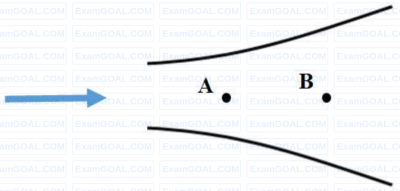Consider an isentropic flow of air (ratio of specific heats = 1.4) through a duct as shown in the figure.
The variations in the flow across the cross-section are negligible. The flow conditions at Location 1 are given as follows:
𝑃1 = 100 kPa, 𝜌1 = 1.2 kg/m3 , 𝑢1= 400 m/s
The duct cross-sectional area at Location 2 is given by A2 = 2A1, where A1 denotes the duct cross-sectional area at Location 1. Which one of the given statements about the velocity 𝑢2 and pressure 𝑃2 at Location 2 is TRUE?

Consider a steady flow through a horizontal divergent channel, as shown in the figure, with the supersonic flow at the inlet. The direction of flow is from left to right.

Pressure at location B is observed to be higher than that at an upstream location A. Which among the following options can be the reason?
In the following two-dimensional momentum equation for natural convection over a surface immersed in a quiescent fluid at temperature T∞ (g is the gravitational acceleration, β is the volumetric thermal expansion coefficient, ν is the kinematic viscosity, u and v are the velocities in x and y directions, respectively, and T is the temperature)
$\rm u \frac{\partial u}{\partial x} + v \frac{\partial u}{\partial y} = g β (T - T_∞) + \nu \frac{\partial^2 u}{\partial y^2} $
the term gβ(T - T∞) represent